Chem 116 Study guides, Class notes & Summaries
Looking for the best study guides, study notes and summaries about Chem 116? On this page you'll find 26 study documents about Chem 116.
All 26 results
Sort by
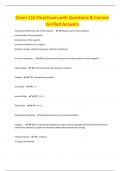 Popular
Popular
-
Chem 116 Final Exam with Questions & Correct Verified Answers
- Exam (elaborations) • 7 pages • 2024
- Available in package deal
-
- $11.99
- 1x sold
- + learn more
Factors that Affect the rate of the reaction: - physical state of the reactants. concentration of the reactants. temperature of the reaction. presence or absence of a catalyst. (Collision energy, collision frequency, collision orientation) In a rate expression... - the products will be positive and the reactants will be negative Intermediate - is first produced, then used as a reactant Catalyst - CRP, reactant than product
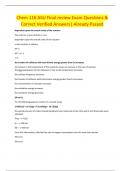 Popular
Popular
-
Chem 116 ASU Final review Exam Questions & Correct Verified Answers| Already Passed
- Exam (elaborations) • 20 pages • 2024 Popular
-
- $12.99
- 1x sold
- + learn more
dependent upon the overall order of the reaction The units for a rate constant, k, are: dependent upon the overall order of the reaction a rate constant is unitless M^-1 M^-1 s^-1 s^-1 the fraction of collisions with total kinetic energy greater than Ea increases. An increase in the temperature of the reactants causes an increase in the rate of reaction. The best explanation for this behavior is that as the temperature increases, the collision frequency increases. the fraction of coll...
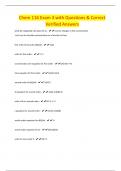
-
Chem 116 Exam 3 with Questions & Correct Verified Answers
- Exam (elaborations) • 11 pages • 2024
-
- $12.49
- + learn more
what do integrated rate laws tell us - current changes in the concentration -can't use to calculate concentration as a function of time first order formula for d[A]/dt - -k[A] units for first order - s^-1 concentration of A equation for first order - [A]=A0 e^-kt time equation for first order - t(1/2)=ln2/k second order of d[A]/dt - -k[A]^2
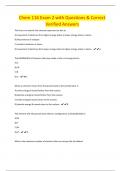
-
Chem 116 Exam 2 with Questions & Correct Verified Answers
- Exam (elaborations) • 11 pages • 2024
-
- $12.49
- + learn more
The lines in an atomic line emission spectrum are due to A) movement of electrons from higher energy states to lower energy states in atoms B) the presence of isotopes C) nuclear transitions in atoms D) movement of electrons from lower energy states to higher energy states in atoms - A The MAXIMUM # of electrons that may reside in the n=2 energy level is A) 2 B) 18 C) 8 D) 3 - C
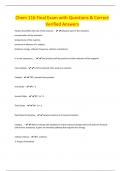
-
Chem 116 Final Exam with Questions & Correct Verified Answers
- Exam (elaborations) • 7 pages • 2024
-
- $11.99
- + learn more
Factors that Affect the rate of the reaction: - physical state of the reactants. concentration of the reactants. temperature of the reaction. presence or absence of a catalyst. (Collision energy, collision frequency, collision orientation) In a rate expression... - the products will be positive and the reactants will be negative Intermediate - is first produced, then used as a reactant
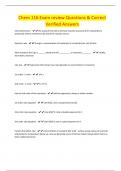
-
Chem 116 Exam review Questions & Correct Verified Answers
- Exam (elaborations) • 5 pages • 2024
-
- $11.49
- + learn more
Chemical kinetics - the study of how fast a chemical reaction proceeds from reactant(s) to product(s) and the mechanism by which the reaction occurs Reaction rate - change in concentration of reactant(s) or product(s) per unit of time Most reactions don't go a ______ speed and will __________ as reactants ________ - steady; slow down; decrease rate law - expression that shows how rate depends on concentration of reactants 1st order - k units - 1/m s
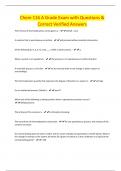
-
Chem 116 A Grade Exam with Questions & Correct Verified Answers
- Exam (elaborations) • 11 pages • 2024
-
- $12.49
- + learn more
The first law of thermodynamics can be given as - DeltaE = q+w A reaction that is spontaneous as written - will proceed without outside intervention Of the following (S, H, q, E, T), only ___ is NOT a state function. - q When a system is at equilibrium - the process is not spontaneous in either direction
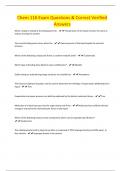
-
Chem 116 Exam Questions & Correct Verified Answers
- Exam (elaborations) • 7 pages • 2024
-
- $11.99
- + learn more
When a liquid is heated at its boiling point the, - Temperature of the liquid remains the same as long as any liquid is present The normal boiling point occurs when the - Vapor pressure of the liquid equals the external pressure Which of the following compounds forms a covalent network solid? - C (diamond) Which type of bonding does Mg form upon solidification? - Metallic
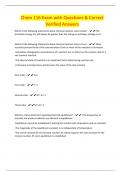
-
Chem 116 Exam with Questions & Correct Verified Answers
- Exam (elaborations) • 5 pages • 2024
-
- $11.49
- + learn more
Which of the following statements about chemical reaction rates is false? - The Activation energy, Ea, will always be greater than the change in enthalpy, (change in H) Which of the following statements about chemical reaction rates is true? - -Most reactions proceed faster if the concentration of one or more of the reactants is increased -Sometimes changing the concentration of a reactant has no effect on the reaction rate for a net chemical reaction. -The physical state of reactants is a...
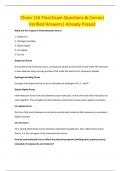
-
Chem 116 Final Exam Questions & Correct Verified Answers| Already Passed
- Exam (elaborations) • 14 pages • 2024
-
- $12.89
- + learn more
What are the 5 types of intermolecular forces? 1. Dispersion 2. Hydrogen bonding 3. Dipole-dipole 4. Ion-dipole 5. Ion-Ion Dispersion forces the weakest intermolecular force; a temporary attractive force that results when the electrons in two adjacent atoms occupy positions that make the atoms form temporary dipoles Hydrogen bonding forces stronger than dispersion forces its an attraction of hydrogen to O, F, and N
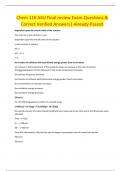
-
Chem 116 ASU Final review Exam Questions & Correct Verified Answers| Already Passed
- Exam (elaborations) • 20 pages • 2024
-
- $12.89
- + learn more
dependent upon the overall order of the reaction The units for a rate constant, k, are: dependent upon the overall order of the reaction a rate constant is unitless M^-1 M^-1 s^-1 s^-1 the fraction of collisions with total kinetic energy greater than Ea increases. An increase in the temperature of the reactants causes an increase in the rate of reaction. The best explanation for this behavior is that as the temperature increases, the collision frequency increases. the fraction of coll...
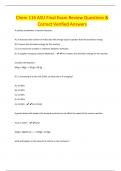
-
Chem 116 ASU Final Exam Review Questions & Correct Verified Answers
- Exam (elaborations) • 10 pages • 2024
-
- $12.49
- + learn more
A catalyst accelerates a reaction because: A.) it decreases the number of molecules with energy equal or greater than the activation energy B.) it lowers the activation energy for the reaction C.) it increases the number or collisions between molecules D.) it supplies energy to reactant Molecules. - B.) it lowers the activation energy for the reaction Consider the Reaction: 8A(g) + 5B(g) --> 8C(g) + 6D (g)

Did you know that on average a seller on Stuvia earns $82 per month selling study resources? Hmm, hint, hint. Discover all about earning on Stuvia


